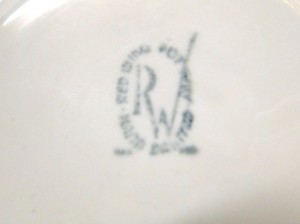There may be a RWCS Chapter near you
Learn more on our Chapters Page.
Membership is only $35 a year and includes six full-color newsletters and exclusive, members only, online content
I recently inherited some of the Magnolia pattern dinnerware. I have searched and searched to find an answer to a question I have concerning the trademark. The dishes have two different trademarks. One is the more popular red Red Wing while the other is an oval shaped design with the RW in the middle and the number 7 underneath. Can you give me any info/history on the trademarks and why they are different? I would appreciate your help.
Sincerely,
Becky
Answer: Red Wing Potteries changed the ink stamp used to mark dinnerware several times over the years. The ink stamp markings applied to the bottom of Red Wing dinnerware depend on when the piece was produced, not the dinnerware pattern. Magnolia dinnerware was made for about 10 years and three different ink stamps were used during that time. The earliest ink stamp was introduced in 1941 with Red Wing’s first hand painted patterns. I call this mark the “upright wing” and it used the same dark ink as the oval mark in your photos. This upright wing mark is seldom found on Magnolia dinnerware because the oval-shaped mark and the Magnolia pattern was introduced at about the same time in the late 1940s. The oval mark was used until 1950, when the familiar pinkish-red wing took over. This mark was used until 1958.
Knowing when the various ink stamp marks were applied can help date your dinnerware. You pieces with the dark oval mark were made in the late 1940s; the ones with the pinkish wing were made in 1950 or later. The mark has little or no effect on the value of a piece. That said, Red Wing sometimes made other production changes that could affect value. For instance, Magnolia dinner plates made in the late 1940s (with the dark oval stamp) are usually much thicker and heavier than dinner plates made later in the 1950s. In this case a collector may have a preference for one type of plate over the other, but the value to the collector has nothing to do with the ink stamp mark.
Larry


